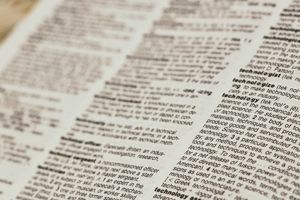✎ Includes an exercise (see below)
PODCAST: read and listen to this entry at the same time (you can find the Spanish text here)
If you’re learning a foreign language, I’m sure that you have more than one bilingual dictionary at home. Dictionaries are a very useful tool to help you learn a language.
Today we’ll talk about different types of dictionaries and what we can use them for. In addition, we’ll examine electronic dictionaries and we’ll talk about machine translations.
Dictionaries vs. machine translations

Machine translations, which we all love to use, and dictionaries are not the same, nor do they help us in the same way. For my part I always tell my students not to use automatic translators if they want to learn a language, do exercises or write essays. And I don’t say it to annoy them.
The reason? Automatic translators are practical when it comes to getting out of a predicament or get the general gist of something. However, they are far from perfect, at least for now. As a matter of fact, lots of times they are completely changing the meaning of a text (they tend to have problems with synonymy). It also happens that when reading such a translation everything sounds “weird”, at least when you’re a native speaker. This is because of terminology, jargon and problems with polarity. Feel free to use them as an aid to help you understand something when you’re on a trip or if you need to know what something means in general. But don’t use them to translate your essays or content you want to publish (unless a native speaker can correct it for you before) because they will contain errors, sometimes big ones, and that will give a bad impression. And the teacher will notice immediately! Apart from that, if you use a pre-translated text you won’t practice the structure of the sentences but only correct some small things or directly approve the translation. Like this you won’t progress.
But how will a dictionary help me? A dictionary helps you because it not only gives you the translation into your language of a word, but it also tells you its function, it gives you synonyms, tells you about collocation, etc., i.e. it gives you several choices to consider. You have to decide which word, verb, etc. to use and how.
Types of dictionaries
Monolingual dictionaries
Monolingual dictionaries give you a word in its original language and describe its meaning. Those dictionaries usually contain words that have been accepted by the official language institution of each country. That means, that they don’t contain all words, only the ones that have been officially accepted. And they point out if they are commonly used or not and, in the case of Spanish, whether they are country-specific. We can include here dictionaries of the usage of a language, too. They contain common terms as well. The dictionary of the RAE and the “Diccionaria de uso del español María Moliner” are two good monolingual dictionaries. This type of dictionary is intended for intermediate and higher levels.
Bilingual dictionaries
These are dictionaries any language student knows and which accompany us for the first few years of studying. A bilingual dictionary helps us to find the equivalent of a word in our language without giving us a definition for it. In general they contain two languages and, depending on the dictionary, they can give us more then one meaning of a word. Those dictionaries are quite useful because they usually include phonetic translations and collocations as well. Furthermore, they are also available in pocket size so you can take them with you to class.
Specialized dictionaries
These dictionaries can be monolingual or bilingual. If you’re learning Spanish for work, they can be useful for learning the vocabulary or jargon of your field of work. There are, for example, business, tourism, legal, technical dictionaries, etc.
Other dictionaries
There are also thesauruses, dictionaries of foreign words, etymological dictionaries, dictionaries dealing with questions about the usage of a language, etc. However, these dictionaries are not so practical for students of the Spanish language. They are intended more for people who are studying for a university degree, like for example in translation, philology, linguistics, etc.
What kind of dictionary should you use? A printed or an electronic version?

Nowadays there’s a huge variety of electronic dictionaries which allow us to quickly search for terms. What is important is to select a dictionary and not a translator. For example, the bilingual dictionaries of PONS and WordReference, among others, are very useful. Those dictionaries offer different translations, collocations, and example sentences. Another thing that makes them quite useful is that they also provide the complete conjugation of the verbs. The PONS dictionary provides in addition the conjugation for Spanish from Spain and Spanish from Latin America. However, what makes them different from the printed version is the possibility to listen to the pronunciation of the words and also in multiple accents. While I still love the printed version, it’s true that it’s slower and that it’s missing the aforementioned features. And, of course, there are many more electronic dictionaries than the two I told you about and they are all very similar to use, e.g. LEO, Cambridge, etc. Try out various and find the one you like the most.
EXERCISE
Credits:
Featured image: Photo by Christin Hume on Unsplash
